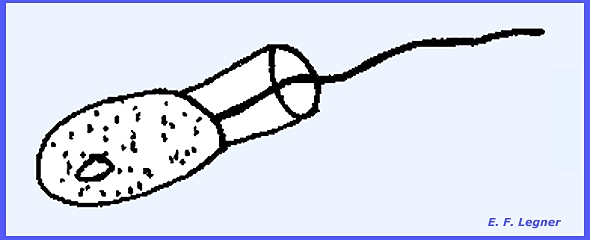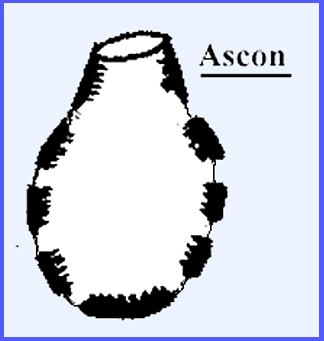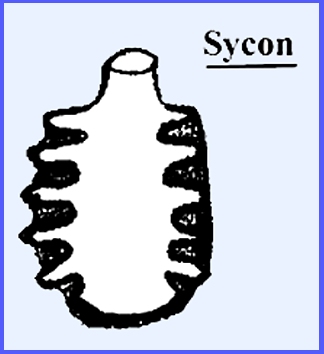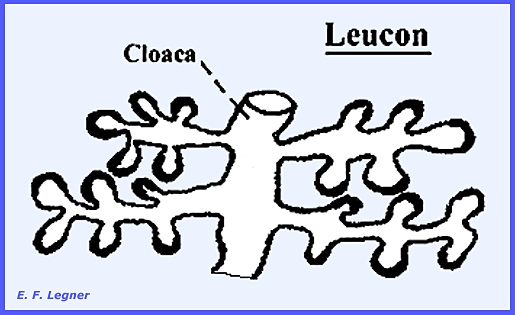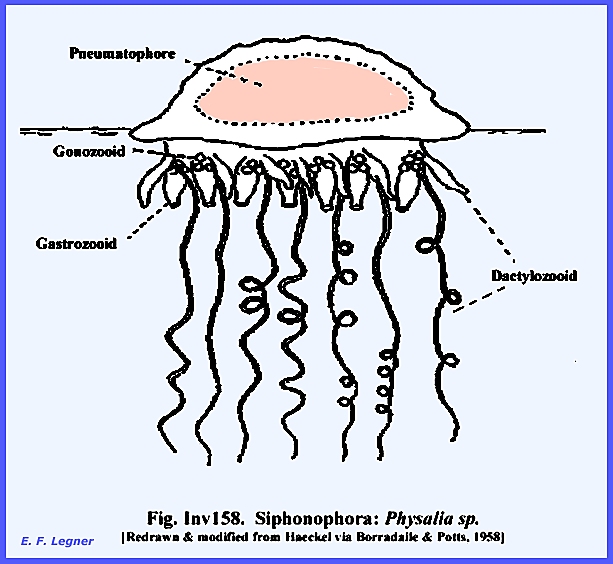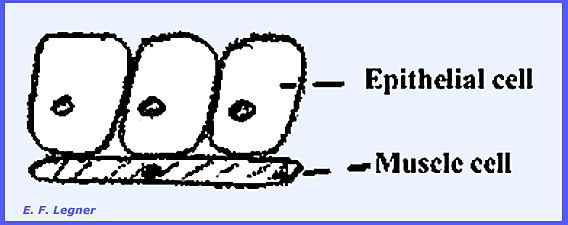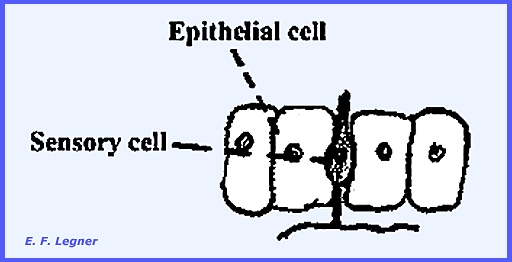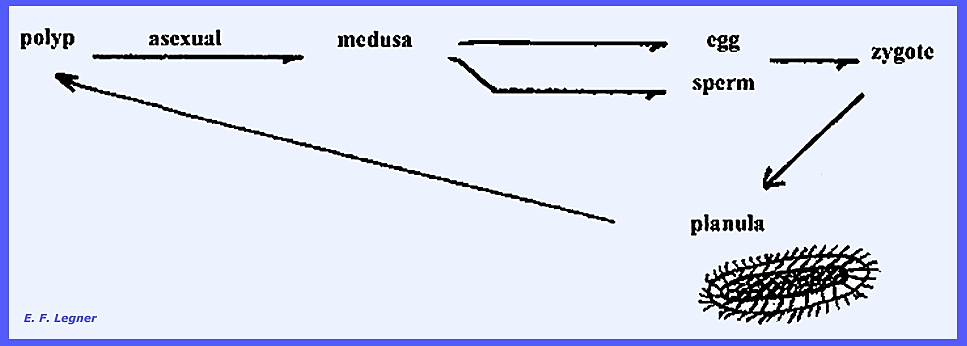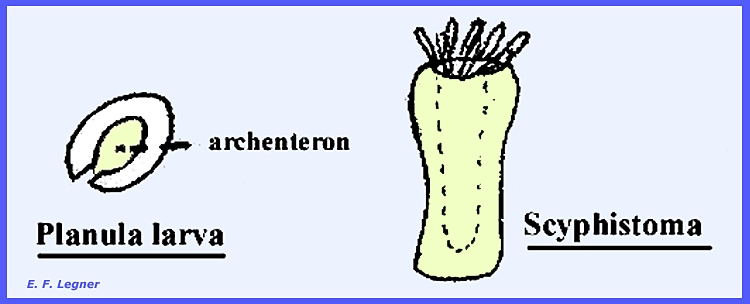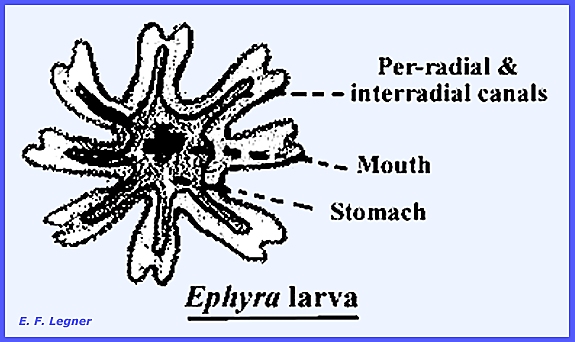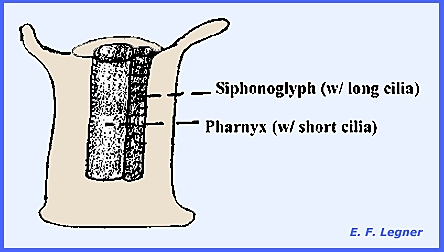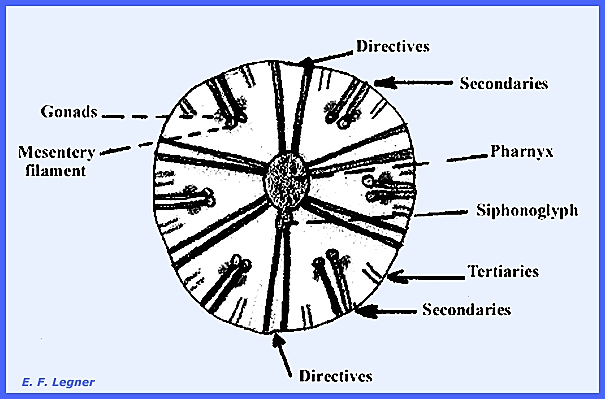File:
<animalia.htm> <Index to Invertebrates> <Bibliography> <Glossary>
Site Description <Navigate to Home>
Introduction Platyhelminthes ►
Invertebrate Zoology
Animalia, Porifera, Ctenophora & Cnidaria (Contact)
CLICK on underlined file names and included illustrations to
enlarge:
------------------------------------ Kingdom: ANIMALIA,
SubKingdom: Parazoa, Phylum: Porifera -- Sponges Three classes of
Porifera will be discussed as follows:
Class: Calcarea that
have a skeleton of calcium carbonate spicules and three body forms (Ascon,
Sycon and Leucon); Class: Hexactinellida that
have 6-rayed spicules of silicon dioxide and a Leucon body type. Most are deep-sea inhabitants and there
are many elaborate and beautiful forms; Class: Demospongia,
the largest group whose skeletons are of silica, spongin or a combination of
both. Their spicules are never
6-rayed and they possess a Leucon body type.
Included here are the fresh water sponges. Porifera have
their entire body perforated with tiny perforations. They are multicellular with simple
tissues. There are neither organs nor
organ systems. The body is porous and
the pores communicate with a system of channels that carries water currents
through the body. No muscle nor nerve
cells are in evidence, there being only epithelia and connective tissue. The adults are sessile. Collar cells or choanocytes exist
that line the interior of the chambers. There is an
intracellular digestion as in the Protozoa where food is taken into cells
directly. They are primarily a marine
group with one family living in fresh water. ------------------------------------ An example of
a typical Porifera is Scypha, which lives in shallow marine environments. It is cylindrical with a prominent crown
2.5 cm. High. There is radial
symmetry and an interior cavity called a false cloaca. Finger-like chambers radiate out of the
chamber and others run in from the outside, all of which end blindly. Connections between the chambers are
minute incurrents and radial canals, the latter having flagellated
chambers. Extremely minute but
specialized pores, called prosopyles,
permeate the entire body and interconnect the chambers. Apopyles occur,
which are openings into the cloaca and these are larger than the
prosopyles. A water current is set up
by the flagella of the collar cells.
The water is directed into the prosopyles, through the apopyles and
into the cloaca from which it escapes via the osculum to
the outside of the animal. Calcium
carbonate may arise from the mesoglea to form spicules.
Respiration
and Excretion.-- These two function
are accomplished by simple diffusion through any or all body surfaces. Support
and Protection.-- The spicules give
support and they may consist of calcium carbonate or silicon dioxide. Protection is afforded by spongin,
a horny protein, which forms an anastomosing network. Both the spicules and spongin are secreted
by the amebocytes. Locomotion
and Movement.-- Porifera are
sessile and immobile. Every cell can
change its shape to some degree. If
all cells contract at once, there will be a minute shrinkage of the entire
body. Sensitivity
and Conduction.-- There are no
special organs for sensitivity and conduction, and cells respond to stimuli
as individuals. A response may be
spread out slowly from cell to cell, e.g., one cell passes a stimulus on to
the next and so forth. Reproduction.--
There are two types of reproduction:
asexual and sexual. Asexual
reproduction may be by budding or gemmules. Gemmules are a kind of budding found only in
fresh water Porifera and where a group of amebocytes clump together in a
spherical mass and then are surrounded by a wall. These form in the mesoglea and they serve to carry-over the
organism in winter, drought, etc. New
individuals are formed from each gemmule. In Sexual reproduction the source
of gametes is in the amebocytes and they are formed by meiosis. Eggs remain in place in the mesoglea of
the parent. Sperm break out of the
mesoglea and leave the parent. They
are taken into the body of another sponge with the water-food current. A sperm cell is then captured by a collar
cell and taken into a vacuole and finally transferred to an amebocyte, which
conveys it to the egg cell. The
fertilized egg develops into a flagellated larva in the mesoglea. Later it escapes to the external
environment as an amphiblastula. Such a curious reproductive behavior
removes this group from a direct evolutionary line in the animals. Body
Forms.-- There are three
body forms in Porifera as noted previously.
In the Ascon Type there is one
large flagellated chamber. There are
no apopyles, incurrent or radial canals and the organisms are extremely
small. The Sycon Type is similar but with a
different shape: The Leucon Type allows for a much
thicker body wall. There is a
reduction of the cloaca, which is divided into a complex series of
channels. This type is found in all
of the larger sponges: All these body type occur in the
Calcarea, but Hexactinellida and Demospongia have only the Leucon Type. The economic importance of sponges has
been almost entirely for the commercial bath sponge. Porifera have been regarded as a blind
alley in evolution. ------------------------------------ Please see following plates for Example Structures of the
Porifera: Plate
10 = Animalia: Parazoa: Porifera: Scypha sp. Plate 11 = Animalia: Parazoa: Porifera:
Calcarea & Hexactinellida (Scypha sp., Hyalonema sp. & Euplectella
sp.) Plate 33 = Phylum: Porifera: Noteus sp.
& Asplancha amphora ------------------------------------ SubKingdom:
Metazoa Phylum: Ctenophora (Previously
under Coelenterata). Included here are the sea gooseberries, sea walnuts and
sea cucumbers (= not to be confused with the Holothuroidea). Two Classes are Tentaculata and
Nuda. Their name is derived from eight
meridially arranged comb rows or ctene. These are a row of locomotory structures
quite similar to the membranelles of the Ciliata. They consist of several rows of cilia fused together to form a
plate or ctene. There is a symmetry that is a kind of
hybrid between radial and bilateral symmetry. Two tentacles are present.
Lasso Cells or colloblasts exist,
which are sticky in nature. However,
there are no nematocysts. There is a
jelly-like mesoglea and a digestive cavity or gastrovascular cavity with a
canal system. Luminescence allows
these animals to glow in the dark.
There is no known economic importance and their evolution is probably
another blind alley, which evolved from a stock similar to the Cnidaria. ------------------------------------ Please see following plates for Example Structures of
the Ctenophora: Plate 67 = Phylum: Ctenophora -- Transverse
section to axis of Corallium sp. Plate 68 = Phylum: Ctenophora --
Structure of an anemone. ------------------------------------ SubKingdom:
Metazoa Phylum: Cnidaria (previously
under Coelenterata). The Cnidaria are primarily marine animals
with radial symmetry. Included are combs,
corals,
jelly
fish Their
tentacles are equipped with Nematocysts, which are stinging structures used
in capturing their prey. Their body form
is a double walled sac with a large central cavity, which is called the gastrovascular
cavity or coelenteron. Three classes discussed here are Hydrozoa,
Scyphozoa and Anthozoa. ------------------------------------ The Class Hydrozoa shows extremes in the
presence or absence of various generations.
Some species possess conspicuous polyp stages and suppressed medusoid
stages. Some show both equally while
others show only a pronounced medusoid stage; e.g., Hydra
spp. has no medusae while Gonionemus
spp. have mostly medusae. The
Order Siphonophora
(Portuguese Man-of-War)
affords the best example of polymorphism in the entire Animal Kingdom. Several kinds of polyps and medusae are
all together in one body. Each serves
a particular function (eg., locomotion, digestion, hunting, etc.). Some corals, e.g., Elk-horn
Coral, are also represented
here. The Class is characterized by
having alternation of generations, medusae with a velum, gonads that are
ectodermal and exteriorly situated, and a completely acellular mesoglea. The genus Obelia
is a colonial representative only a few inches high. There is a branched, plant-like stalk and
the animal is common in coastal North America where it may be found attached
to any submerged surface in salt water.
The gastrovascular cavity is continuous throughout the colony. Food
and Digestion.-- Members of the
genus are carnivorous. They use nematocysts
to catch their food. These are elaborate inclusions within
cells. There is an explosion of a
thread from the nematocyst when there are physical or chemical stimuli. The force in ejection probably involves an
osmotic process. The thread contains
a poisonous substance that may kill, paralyze or occasionally trap the prey
in a sticky secretion. Nematocysts
are located in greatest numbers on the tentacles, but they may also be
scattered throughout the body. The food is
stuffed through the mouth and into the gastrovacular cavity. Digestion commences in the gastrovascular
cavity, and proteineous enzymes are secreted by the gastrodermis. Digestion is completed
intracellularly. The gastrodermal
cells can send out pseudopodia, which engulf small solid food particles. Egestion is also through the mouth. Circulation.--
flagellated cells that line the gastrovascular cavity and create a current
accomplish this. The epidermis gets
its food by diffusion across the mesoglea.
Respiration.--
There is a simple diffusion on any or all body surfaces. Support.--
They may possess a secreted cuticle, which surrounds the stalks and hydranths
of the colony or the mesoglea supports the animal. Protection.--
This is afforded by the nematocysts, which can sting and paralyze other
organisms. Movement.--
Epithelio-muscular cells are present. Usually the basal portion of the cell
extends arms of striated muscles, which are simply extensions of the base of
the cell. In the course
of evolution the muscle cell came
into being and served solely as such.
Muscles are arranged in layers under the epidermis or gastrodermis. Many hydroids are sessile, so they
do not move, with the genus Hydra
being an exception. Jellyfish and
related forms are moved by the current, although their tentacles and body as
a whole may supply some motive force. Sensitivity.--
A Nervous System
is
present with nerve and
sensory
cells which are sensitive to
all standard environmental stimuli. The system
consists of (1) a plexis of nerve fibers without any organization into nerve
cords or centralization into ganglia, and (2) transmission of nerve impulses
is not polarized and the impulse can move in any direction. There are Reflexes,
which are primarily concerned with feeding movements. For example, in Hydra spp. all
tentacles contract over a food particle and the mouth opens. Sense Organs are
found only in medusae. These are statocysts and
simple eyes, which are organizations of several cells into a very simple
organ. Reproduction.--
Alternation of Generations is common: Polymorphism occurs
where the same species can exist in more than one body form. The genus Obelia has hydranths,
reproductive polyps and medusae. Medusoid Body Form.--
This is a free-swimming form that is not too fundamentally different from a
polyp, except that a medusa has much more mesoglea than a polyp. The principal radii are those that emanate
from the four corners of the stomach and are called per-radii. Additional radial canals may occur between
them. A velum is found only in the
Hydrozoa. Gonads hang
down from the radial canals and are derived from the epidermis and located
exteriorly. Eggs and sperm are shed
directly into the water. ------------------------------------ Please see following plates for Example Structures of the
Hydrozoa: Plate
12 = Animalia: Cnidaria: Hydrozoa: Obelia sp. Plate
13 = Animalia: Cnidaria: Hydrozoa: Gonionemus sp. Plate
14 = Animalia: Cnidaria: Hydrozoa: Campanula
sp., Hydra sp., Eudendrium
sp., Gonionemus sp. Plate 15 = Animalia: Cnidaria: Hydrozoa: Tubularia
sp., Bougainvilla sp. ------------------------------------ The Class Scyphozoa includes
the cup animals or jellyfish. They
are characterized by a medusa without a velum, gonads that are endodermal in
origin and located internally. The
mesoglea does have some cells and fibers (= loose connective tissue). Internal tentacles serve as gastric filaments. The polyps are a very small, inconspicuous
and short-lived larval form. All are
marine species, and their size varies up to about two meters in diameter. A
representative species is Aurelia aurita, which is found in inshore waters of
coastal North America. The species
has radial symmetry and no velum.
There is a canal system that is much more complex than that found in
the Hydrozoa. There are oral
lobes where
the corner of the mouth is pulled far out and bears nematocysts on tentacles. A subgenital pit has
no obvious function, but may serve to make a closer contact between seawater
and the stomach. Food
and Digestion.-- Aurelia is
carnivorous and may catch some larger fish.
It has a stomach that is subdivided into four lobes: Digestion
begins extracellularly and terminates intracellularly as in the
Hydrozoa. Gastric tentacles secrete
enzymes and bear nematocysts; they also create a water current. Respiration
and Excretion.-- These are
accomplished by simple diffusion as in the Hydrozoa. Support.--
Only the mesoglea, which may be rather stiff, supports the organism. Movement.--
There are muscles of the epithelio-muscular variety that allow for
movement. The muscles occur in strong
bands around the circular portion of the body. However, most movement is planktonic. Sensitivity
and Conduction.-- These are very
similar to the Hydrozoa except that the sense organs are more elaborate and
are called Tentaculocysts. Each contains a statocyst,
eyespot
and olfactory pits. There is a diffuse conduction through a
network of neurons without any coordination. Life
History.-- Auralia is
dioecious. Eggs and sperm are borne
internally in the endodermis.
Fertilization occurs in the digestive cavity. The development of eggs begins in the gastrovascular
cavity and is completed at the tips of the mesenteries where they give rise
to a hollow planula larva, which possesses an archenteron. The larva develops into a small polyp
called a scyphistoma, which is very
inconspicuous. A peculiar
budding type occurs where a linear arrangement of buds is assumed. This is called the Strobila
Stage. Buds detach to form free ephyra,
which are actually juvenile adults.
These are a free-swimming stage that gradually grows into the adult. An alternation of generations
exists but is inconspicuous. Commensals and Symbionts.--
Some fish are able to live inside the tentacle mass and are not injured by
the nematocysts. Also, some jellyfish
have symbiotic algae in their cells. ------------------------------------ The Class Anthozoa includes
the "flower animals," which includes
the sea anemones, horny corals and calcareous corals. There is only a polyp stage. The oral end of a polyp is expanded into a
disc, which bears tentacles either on the rim or scattered over the disc. They have a stomodaeum
or gullet, which is ectoderm that has turned
in at the mouth. The gastrovascular
cavity is subdivided by vertical partitions called mesenteries
or septa.
These greatly increase the surface area in the gastrovascular
cavity. Gastric
filaments exist that are equipped
with nematocysts and they begin along the sides of the free edges of the
mesenteries, terminating freely in the gastrovascular cavity. A mesoglea serves
as a sort of connective tissue and it consists of cells and fibers. These are more specialized than in the
Scyphozoa where there are only scattered cells. The gonads are endodermal in origin and located internally. Two Subclasses divide this group as follows: The Subclass Alcyonaria
includes the sea
pens, sea
pansies, sea
fans and
sea whips.
All species of Alcyonaria are colonial and possess a horny skeleton
consisting of proteinaceous material.
There is a relatively simple body construction of eight pinnate
tentacles and eight mesenteries. The
polyp organization is simple, but elaborate colonies are formed. The Subclass Zooantharia
includes the sea
anemones
and stony
corals. Their structure is more complicated than
that of the Alcyonaria. Sea anemones
are solitary while corals are mostly colonial. There are six pairs of septa as in the genus Metridium, and a general
tendency towards bilateralism. The stony
corals have a calcareous skeleton.
They occur in the form of cups in which resides a polyp. A partition of skeletal material has
pushed into the body wall but does not penetrate the wall, and therefore it
remains external and is secreted by the epidermis. The Genus Metridium represents the
Zooantharia. The species are from
inshore waters where they may be found attached to any firm object
underwater. There is a cylindrical
column with a basal disc and several rows of tentacles. The tentacles are hollow and not as long
as in the other classes of Cnidaria.
The body wall consists of an endodermis, ectodermis and cellular
mesoglea. Food
and Digestion.-- Any animal within
range of the tentacles is attacked.
Small food particles are conducted down the tentacles toward the mouth
in a regular stream, while larger food particles are passed into the extended
mouth. Digestion is the same as in
other Cnidaria being extra- and intracellular. Nematocysts occur in the gastric filaments, which sting the
prey to death. Circulation.--
A highly ciliated siphonoglyph is
a side chamber of the gullet that aids in the process of respiration by
forcing a current of water down the gullet.
Its action also aids in keeping the food constantly stirred up in the
gastrovascular cavity. There are six
pairs of mesenteries, which are referred to as primary
mesenteries, and two pairs of
mesenteries that lie on the siphonoglyph and opposite to it, which are called
directives. Secondary mesenteries alternate between
the primaries. Tertiary and
quaternary
mesenteries may also be
present. All the mesenteries except
for the primaries have free edges. A mesentery
filament is present, which is a
vertical tube that joins the free ends of the mesenteries. Excretion.--
The main nitrogenous waste is ammonia and this is released by simple
diffusion. Muscles.--
These are usually the epithelio-muscular cells. Movement.--
Sea anemones have very slow, creeping movement by use of muscles inside the
basal disc, while other members of the group such as the corals are
stationary. Sensitivity.--
There are no sense organs present in the polyp stage, which is the only stage
present in the Anthozoa (only medusae have sense organs). However, the polyp tentacles and oral disc
are most sensitive but do not constitute organs. Reproduction.--
Both sexual and asexual reproduction are present. In sexual reproduction there are separate sexes
(dioecious). Gonads are borne
primarily on secondary mesenteries that are located in back of the free
edge. Gametes are shed into the
gastrovascular cavity and sperm leaves the body to enter that of another
polyp. Fertilization takes place in
the gastrovascular cavity where the eggs develop into the planula larva,
which is hollow and which swims out and eventually settles on the
ground. The polyp reproduces sexually
again and therefore there is no alternation of generations. Asexual
reproduction involves pedal laceration,
where pieces of the basal disc may break off and leave young polyps behind
it. However, continuous asexual
reproduction results in abnormal individuals. In some cases
the more normal type of budding results in the formation of large colonies. Economic Importance.--
There is little or no direct economic importance. However, indirectly corals form islands and their presence
allows for human habitation. The
horny skeletons of red corals have been used as jewelry. Hydra have been used with some success to
combat mosquitoes (See
Mosquito
Suppression With Hydra). ------------------------------------ Review of Cnidaria
Characteristics The origin of
the Cnidaria is obscure, but they are probably derived from a colonial
flagellate with a solid colony that had a planula larva. Their Protista features are a final
digestive phase being intracellular and the absence of specialized excretory
or respiratory structures. Their more
advanced features include well-organized tissues with specialization within
the tissues (the epidermis is more highly specialized than that of the
Porifera). The digestive cavity is
the initial site of digestion. There
are the beginnings of structures that warrant the name of organ. Muscle cells are present in the form of
epithelio-muscular cells as well as distinct muscle cells. Polymorphism and Alternation of
Generations occur. Polymorphism is a
mechanism by which a very simple animal can obtain some division of labor
without the need for highly specialized tissues. After polymorphism came into existence, the alternation of
generation probably arose. For
example, the polyp represents the original larval stage, which has become more
and more prominent, and the medusa because of its sense organs suggests that
this was the original adult form. ------------------------------------ Please see following plates for Example Structures of the
Cnidaria Plate
16 = Animalia: Cnidaria: Scyphozoa: Aurelia sp. Plate
17 = Animalia: Cnidaria: Scyphozoa: Scyanea sp. & Aurelia
sp. Plate
18 = Cnidaria: Anthozoa: Zooantharia: Metridium sp. (Figs. A & B) Plate 19 = Cnidaria: Anthozoa: Zooantharia: Metridium sp. (Fig. C) ============== |
Introduction Platyhelminthes ►
